How Do You Know if You Name Is Ranked High in Google
SEO is slow. It can take years to build your authority and rankings. Search engine optimization is the slowest class of marketing I know of. Information technology really is.
But there'southward 1 big shortcut.
The key is to focus on the right pages and phrases. You lot probable already have pages that rank, but don't nevertheless rank high. If you use Analytics to find a folio with "striking distance" keyphrases, and then you tin can update that page and improve the rank very chop-chop.
Here's the quick summary, then we'll go into item.
- Observe the phrases for which you almost rank high.
- Ostend the ranking in Google search results.
- Improve the page past making information technology more focused on the phrase.
- Wait 3 days. Check the rankings!
This post is our stride-past-step guide to improving your Google rankings and search traffic fast. It's the only SEO short-cut that I know of. I've done information technology hundreds of times for dozens of clients and I'thousand happy to share information technology with y'all.
If y'all've never washed this before, there may exist huge opportunities to meliorate your Google rankings waiting for you lot in your Analytics.
There is no need to research keyphrases, because Analytics will requite yous the phrase.
At that place is no demand to cheque the competition, because it'southward already ranking in Google.
That'southward why this is the shortest path to increment Google rankings with the smallest possible try. The entire 9-stride process will accept under ten minutes. Sound proficient? Permit's become!
1. Have a look at the "Queries" study
Showtime, you need to discover all the keyphrases that you're almost ranking loftier for already. The data is in Google Search Console, but you lot tin can access it from within Google Analytics hither: Acquisition > Search Engine Optimization > Queries. This report shows:
- All the phrases your website rank for (search queries)
- The number of times you've appeared in Google for each phrase (impressions)
- The number of times your site has been visited for each phrase (clicks)
- Your general ranking for each phrase (average position).
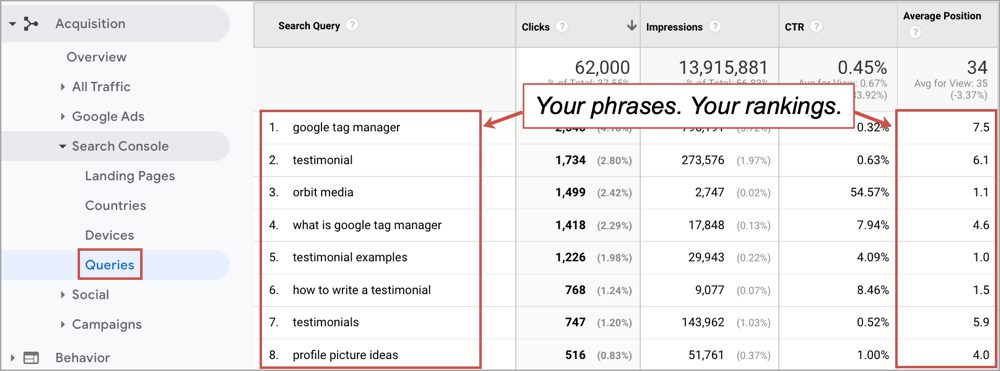
Notation: If this report is bare, you haven't connected Google Search Panel to Google Analytics yet. This article and video testify the procedure. Or you could practice everything in Search Panel, only the tools in Analytics are probably more familiar to you. If you're not familiar with Search Panel here'southward our beginner'southward guide.
If there isn't much data here (impressions for each query are very low) then set a longer date range. Continue in mind that this report shows no data for the terminal two days.
2. Gear up an avant-garde filter to see the striking distance keyphrases
You're looking for the best opportunities for higher rankings. That ways phrases for which you rank, but not that loftier. So you demand to filter this study.
Because yous need to filter for the Average Position cavalcade (which isn't the start column) you have to use an advanced filter. We honey avant-garde filters. They're an easy fashion to get to the best insights fast. Click the "avant-garde" link next to the filter box at the superlative of the main information table.
You're going to tell this written report to show united states all the phrases for which we rank loftier on page ii of Google. So we'll set the advanced filter to include queries when the average position is greater than 10. Here's what that filter looks similar.

Where'southward the all-time identify to hibernate a dead body? Page ii of Google.
No 1 wants to rank on page two, but the good news is, high on page two is almost page 1. You lot're right beneath an important SEO threshold. This is the low-hanging fruit.
three. Sort the study past rankings
Click the cavalcade header "Average Position" to sort the study. Actually, you'll accept to click information technology twice so you lot can see the 10s and 11s at the elevation.

ProTip! Salve this written report.
Save your filtered, sorted Queries report so information technology's easier to get to side by side time. Just click the Save button above at the height (next to the floppy disk icon), proper name it and click OK. At present the study will be available anytime in the Customization > Saved Reports section at the summit of the left-side carte.
4. Browse through the striking distance keyphrases
You'll quickly detect some strange phrases. Every site ranks for weird, seemingly-irrelevant phrases. But browse by them and keep looking. You tin can add to your advanced filter to remove some of these queries if yous'd like.
Ideally, yous'll find some prissy, transactional keyphrases. Retrieve, in that location are three kinds of keyphrases that indicate three types of intent.
- KNOW (informational queries… aka question marks)
These people are simply looking for information. They accept an idea or question, but no plan to buy annihilation. Example: "why does cold water hurt my teeth?" - Do (transactional queries… aka dollar signs)
These people are researching a product or service. They know they need something and they may be ready to human activity. Example: "emergency dentist chicago" - GO (navigational queries)
These people are actually just trying to get to a website. The visitor name is all or function of their query. Case: "Happy Smiles Dentistry"
We're actually looking for the KNOW and DO phrases, which are unremarkably aligned with the blog posts and service pages. Obviously, the transactional queries are the nigh valuable.
 | John Hall Relevance"It's a vital office of growth marketing for us to understand the know, do, and go phrases. Combining areas like PR, Idea Leadership, and SEO are an effective fashion of winning in organic growth and industry trust. Planning out your transactional queries will benefit conversions to increase revenue, but to keep trust in getting journalists and industry leaders to refer to your site you want to make sure you are naturally owning the know phrases equally well. Companies who are strategic on this balance typically come up out winners. " |
Tip! Although the GO phrases aren't relevant here, they tin exist a valuable source of quick insights. If you haven't Googled your visitor name for a while, check out our guide for branded query SEO.
Find a few good phrases? Great. Allow's move on.
five. Ostend your rankings
Start searching for the phrases in Google to confirm your rankings. Y'all'll immediately notice that the "average position" really isn't the aforementioned every bit rankings. Sometimes, you'll run across rankings higher than the report suggests. Other times, yous won't see your site at all.
There are a lot of reasons for the discrepancies.
- Your site may rank differently today than the average beyond the date range in the report
- Your site may have more than one page that ranks for the phrase
- Your site may rank in a SERP feature (the local 3-pack, image search results, etc.)
- Your rankings may exist pushed down by SERP features
- Your search results may be personalized for you based on your location, browsing history, etc.
You can avoid that terminal issue past doing a few things before you search: logging out of Google, using a "individual" or "incognito" window, using a browser you don't usually use, using a proxy server to connect to Google or using Google'south Ads Preview tool.
Note: Really, in that location is no such thing as an entirely neutral search. All searches are affected by implicit search signals. So don't worry too much about trying to be anonymous. You're not looking for super accurate data. You're looking for clues.
Find a page that ranks for a phrase, but not too high? Great. Let'southward go on going!
half dozen. Check the other phrases that this page ranks for
This is of import. Before you lot start editing the folio to optimize for this almost-high-ranking keyphrase, y'all first need to see all the phrases the page ranks for, then you don't accidentally de-optimize information technology for an fifty-fifty better keyphrase.
Here you'll use another Search Console study to answer the 'what do I rank for?' question.
To see every phrase that any folio ranks for, become to the Acquisition > Search Console > Landing Pages study. If you don't see the folio you're looking for at the peak of the list, put the URL into the filter. In that location's no need for an advanced filter this time because y'all're filtering for the first cavalcade.
Here's what the report looks like:
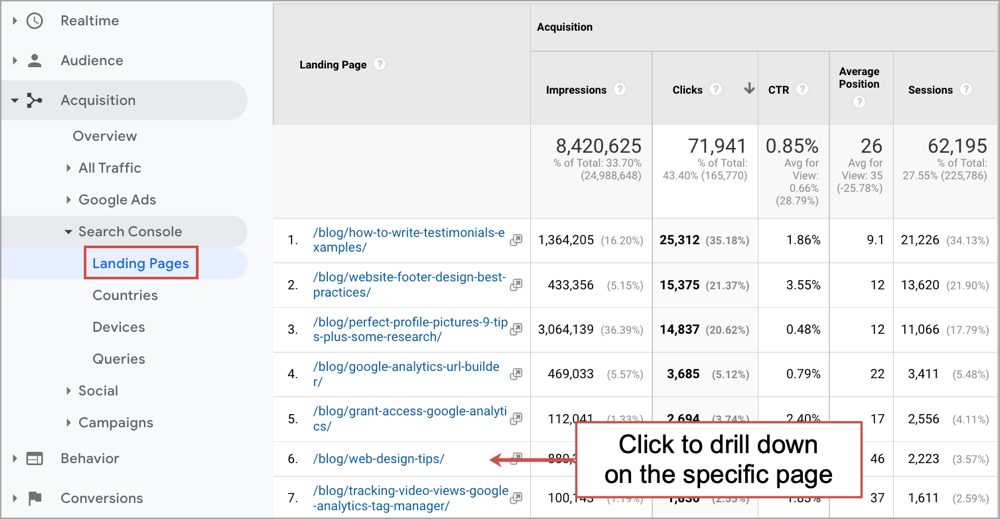
In one case you notice information technology, click on the URL to "drill downwards" into the next level report, which in this case is the Queries report for but that URL. Here y'all get. You are looking at a listing of every phrase that your page ranks for. Sort by clicks.

Now you know the top-performing keyphrases for this folio. If the phrase y'all discovered in Step 4 isn't the one winning the nigh clicks, proceed cautiously. You lot may still be able to meliorate the page's relevance for the phrase, merely be careful y'all don't reduce the relevance for the other phrases.
Alarm! If the top-performing phrase for this page is already in the page championship and H1 header, don't remove it from those places. But skip to Footstep 8.
seven. Check the keyphrase usage on the page
Now we desire to check if the page was really optimized for the striking distance phrase. Does the phrase appear on the page in the most important places? Was the phrase in the title, header and body text?
It'due south possible that the phrase hardly appeared on the page at all. It's possible the ranking was completely by accident. If then, you lot now have an opportunity to indicate the relevance and improve the rankings with very little try.
You can check using the Control + F test.
This is only the "find" feature in the browser. It shows the keyphrase usage on the page. To check if the keyphrase is in the title, look at the text in the browser tab.
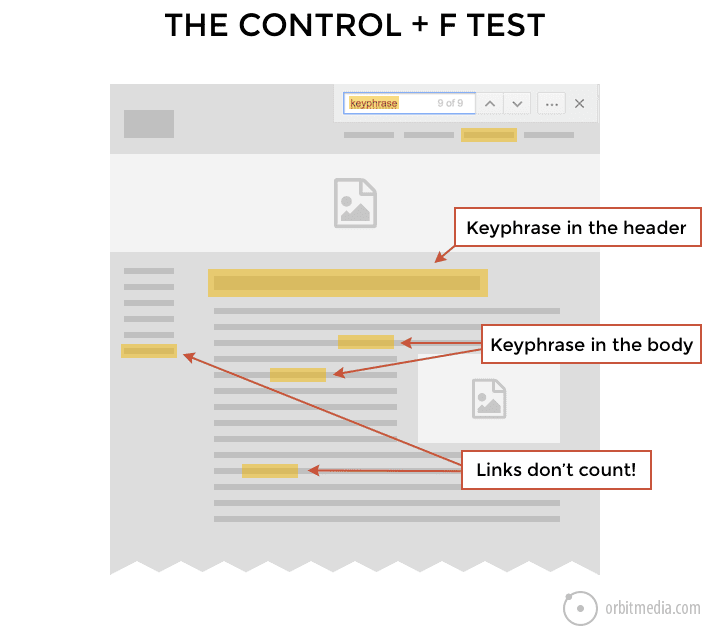
- Does the phrase appear on the folio?
- Where does it appear? In the championship, header and body text?
- Practise the words announced together equally a "bonded phrase", or is it cleaved upwardly?
- How many times is it used in each location?
If the phrase isn't in the title, header and body text, and then this page wasn't really optimized. The Google rankings were accidental. You take institute a page that wasn't well optimized.
Search engine optimization is all nigh indicating relevance. We indicate the relevance using on-page search engine optimization best practices, which we'll summarize here.
The keyphrase is used once in the folio title:
- This is the <title> tag, which appears in the lawmaking, but not on the folio itself. It does show upwards in the browser tab and it's frequently the clickable link in Google search results. If your site is in WordPress, the titles may be managed within a plugin such as Yoast. Ideally, the target phrase appears at the first of the title and words of the phrase are kept together, with no words breaking it upward.
The keyphrase is used in one case in the header:
- This is the <h1> tag, which is the headline at the meridian of the folio.
The keyphrase is used several times in the body text:
- There is no magic number for keyword frequency, but there is a correlation between length and rankings. Remember, Google is a research tool built by library scientists. Google loves deep content. If your page is 1500 words, it's likely that 3 or iv instances of the phrase feels natural.
viii. Make it a better page with "semantic SEO"
Now that you covered the nuts, information technology's time for some adjacent level search engine optimization.
If you hope to rank on page ane of Google, your goal is to literally make ane of the ten best pages on the internet for the topic. Don't just add keywords. Add value. This is really all about the reader and making information technology a ameliorate page in any way yous can.
Here is a list of things y'all tin add to a folio to improve its quality:
- Formatting (subheads, bullets)
- Contributor quotes
- Research data and stats
- Images (especially charts and diagrams)
- Examples
- Embedded video
- Internal links
- Depth, item and answers on the closely related topics
That last 1 is the most important. If you add together particular that is closely related to the main topic, this shows the search engine that the page is indeed ane of the best pages for the main keyphrase.
Search engines don't really match letters, words and phrases. They match the searcher's intent with pages that cover that topic. This is chosen Semantic SEO.
Target the topic, non just the keyphrase.
If it's not obvious what detail to add together and what subtopics to cover, there are tools and techniques to guide you. We'll do this two ways: first by hand, then with a tool.
Semantic SEO by manus
To notice the words and phrases that are semantically linked to your topic, start with the other phrases from the report in Pace six. Then look for clues right in the search results pages:
- Google advise / autocomplete
Just starting time typing in your target keyphrase and see what Google suggests. Enter the phrase into KeywordTool.io to many more phrases suggested by Google, YouTube, etc. - People also inquire box
These are the questions and answers Google believes to exist related to your topic. It is a goldmine for the SEO content marketer. Enter the phrase into AnswerThePublic.com to see many more questions. - Related searches at the lesser of a search results page
Await for related phrases at the bottom of the page. Any phrases y'all missed? Click a few. Keep digging. - Bolded text in the listings of other high ranking pages
Less obvious only simply what you're looking for. If Google bolded the text, it'south stiff evidence that the phrases are semantically related, deep within Google's summit-underground ontological library.

Garther upwards these related phrases, questions, answers and subtopics. Then use these ideas to build upwards the content.
- DON'T just squeeze in the phrases here and there.
- DON'T cram in a sentence packed with these phrases at the stop of the mail. Tastes like copypasta.
- DO add relevant sections and paragraphs that become into item. Build up the structures of the post, turning short paragraphs into new sections, complete with bullet lists and subheads.
Semantic SEO with a tool
After you've exhausted all of the ideas generated through manual research, try a tool. Each of these is a paid tool. You'll need a subscription (perchance $100/month) or a complimentary trial. But they apply competitive analysis to chop-chop uncover new ideas for improving your article.
- Buzzsumo Content Analyzer (top shared articles on whatsoever topic)
- SEMrush On Page SEO Checker (semantic ideas study)
- SEMrush SEO Writing Assistant (writing tips equally you write)
- MarketMuse Optimize
Let's accept a closer look at that last tool.
MarketMuse makes semantic SEO changes prescriptive and well-nigh fun. Just enter the target keyphrase and the URL. MarketMuse will so evidence you a list of semantically related keywords, how many times you lot used each and the average number of times the other loftier-ranking rivals used each phrase.
Information technology looks like this:
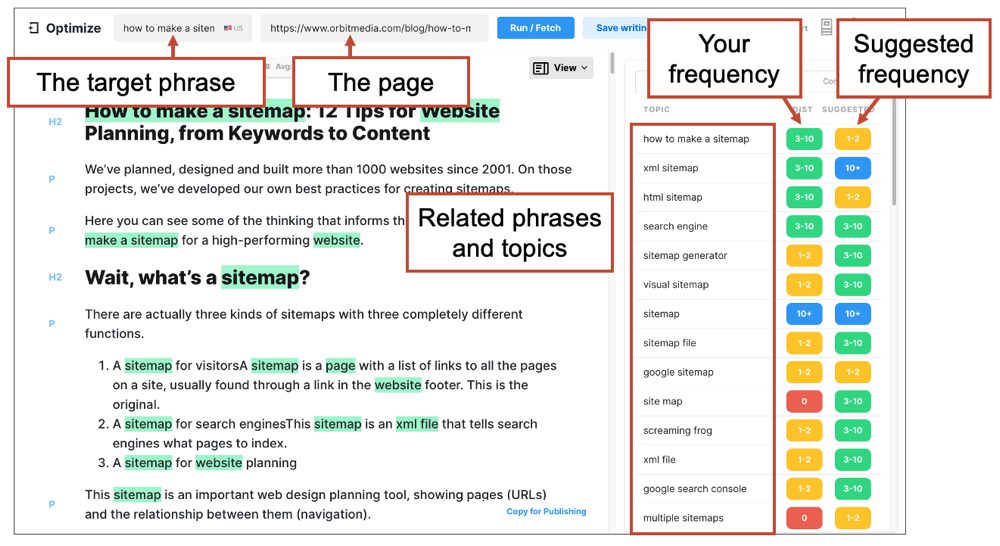
Now equally yous add together paragraphs, it will proceed updating your keyphrase usage and frequency. Information technology also shows word count and "content score," which is their metric for keyphrase relevance. Once y'all accomplish their target content score, motion the revised content into your content management organization.
Got the page all polished upwards? Made it more than detailed, comprehensive and helpful?
Hit the publish button.
9. Await a few days …then check your rankings
How'd yous practise? Ranking a bit college? Often the changes happen within three days. If you lot don't see a alter within a calendar week, you probably aren't going to come across a modify at all.
If the page wasn't well optimized to brainstorm with, a few small changes can have a big bear on on rankings.
The full time to find a phrase and update the page with unproblematic edits takes under 10 minutes. For a page that is already optimized or a phrase that is more competitive, a small-scale rewrite tin can take hours.
Either way, the results are often dramatic and visible inside a few days. Hither'south an instance of an email I received a week after going through these steps with a client…
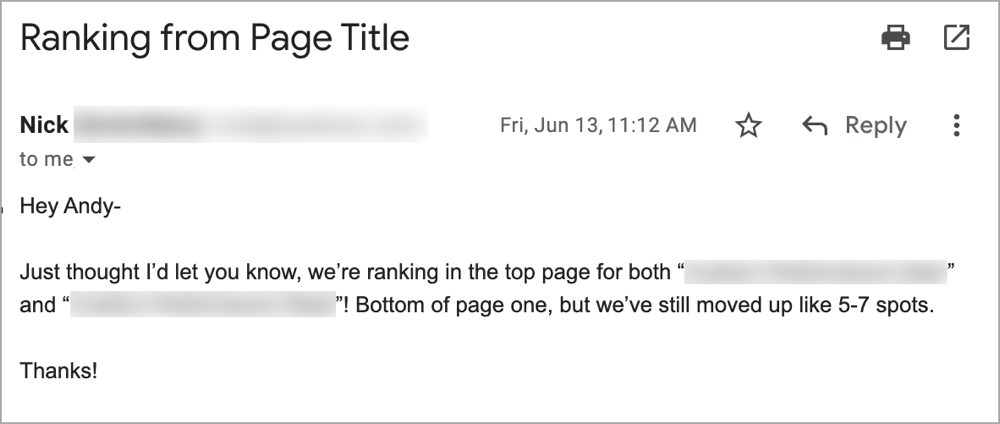
Information technology'south the fastest way to amend your rankings and information technology works really well. The but downside is that at that place are just so many opportunities. Somewhen, you'll take eaten all of the low hanging fruit and you'll take to move on to new content and new keywords.
Next: How to Write a New Web log Postal service for SEO (with high-speed video)
That's why it'due south chosen SEO…
Information technology's called search engine optimization because it involves iterative improvements over time. It's not something y'all exercise in one case. Information technology'south a job that'due south never really finished. The opportunities are literally endless.
Find opportunities in the information …update the content …track the rankings/traffic improvement …repeat!
Source: https://www.orbitmedia.com/blog/improve-google-rankings/
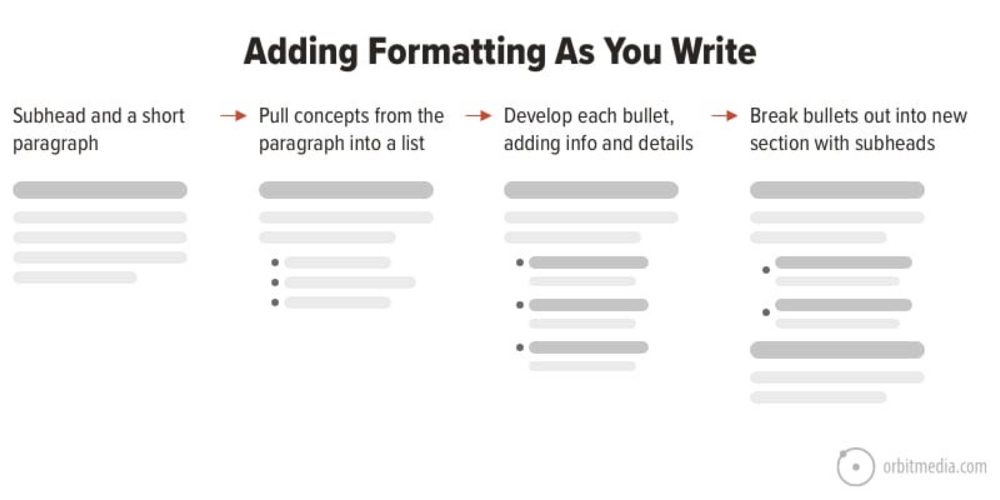
0 Response to "How Do You Know if You Name Is Ranked High in Google"
Post a Comment